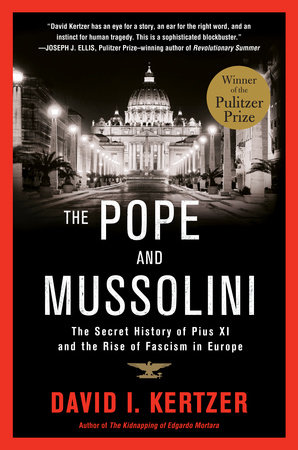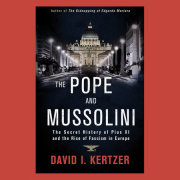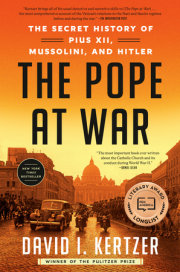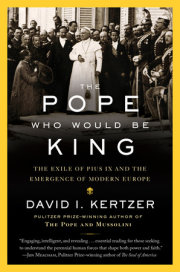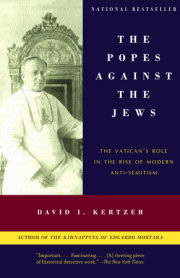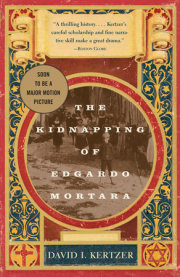Chapter oneA New PopeOutside the Vatican gate, a small crowd gathered, applauding the black sedans as they slowly made their way inside the medieval wall. In recognition or appreciation, or simply from habit, each arriving cardinal waved a hand in ecclesiastical benediction from his backseat. Standing on either side of the gate was a harlequin-clad Swiss Guard, his white-gloved hand raised to his gleaming helmet in salute. A little later, once the last cardinal had found his room in the Apostolic Palace, six officials scurried through the long, cold halls, each swinging a bell. A voice shouted “Extra omnes!” as the last of the outsiders exited. Clutching a massive antique key chain, a Chigi prince, the conclave’s ceremonial marshal, locked the heavy door from the outside. Cardinal Pietro Gasparri, the chamberlain, locked it from within. The windows were sealed. It was Thursday, February 2, 1922. The doors would not open again until there was a new pope.
Only two weeks earlier a persistent cough had begun to bother Pope Benedict XV. Although he was a small, frail man who since childhood had walked with a limp—the Vatican gossips called him the “little one”—he was not old and had enjoyed good health during his seven years on St. Peter’s throne. But what began as bronchitis quickly turned into pneumonia, and the sixty-eight-year-old Benedict took last rites. The next afternoon, lying on his simple iron bed, he lost consciousness. The following morning, January 22, he was dead.
Giacomo Della Chiesa had been an unusual choice when the genial but repressive Pius X died in 1914, just as the Great War began. When the fifty-two cardinals assembled in late August that year to elect a successor, Della Chiesa had been a cardinal for only three months. Born to an aristocratic but far-from-wealthy family, respected for his intelligence and good judgment, he did not look the part of a pontiff. Although dignified in bearing, and courtly in manners, he was undersized, with a sallow complexion, an impenetrable mat of black hair, and prominent teeth. Everything about him seemed slightly crooked, from his nose, mouth, and eyes to his shoulders.
As a young priest, Della Chiesa worked in the Vatican Secretariat of State, which deals with the Holy See’s relations with governments around the world. There he made his way through the ranks until 1913, when he was sent to Bologna to become its archbishop.
Some believed that Della Chiesa’s departure from the Vatican was the work of Cardinal Rafael Merry del Val, Pope Pius X’s secretary of state and his main partner in the crusade to stamp out any sign of “modernism” in the clergy. Pius X worried that modern ideas were replacing the Church’s centuries-old teachings. Particularly noxious, in the pope’s view, were beliefs in individual rights and religious freedom, along with the heretical notions that church and state should be separated, and that faith should come to terms with the lessons of science. Believing Della Chiesa to be too moderate, Merry del Val wanted him far from the seat of Church power.
On the tenth ballot, Della Chiesa reached—just barely—the two-thirds vote required. One of Merry del Val’s fellow hard-liners, Cardinal Gaetano De Lai, humiliated the new pope by demanding that his ballot be examined to ensure that he had not voted for himself.
Pius X had died at a frightening time for Italians, but his successor’s death, in 1922, came amid even greater unrest. Many feared that revolution could erupt at any moment, although they differed on whether it was more likely to be sparked by the socialists or the fascists. The Great War, which the elite had hoped would help unify the hopelessly divided Italians and rally the population around the government, had done neither. Over half a million Italians had died, and even more had returned wounded. A demobilized army came home to find few jobs. The country’s political leaders seemed incapable of finding a way out of the crisis.
The Socialists—whose numbers had been growing for decades—had hoped to ride the tide of popular anger to power. Workers occupied factories in Turin, Milan, and Genoa. Agricultural laborers struck, threatening the old rural landowner class. Only two years earlier, in 1917, a communist revolution had brought the Bolsheviks to power in Russia and destroyed the old tsarist order. Energized by their example, Italian protesters dreamed of a future when workers and peasants would rule.
But the Socialists had to face a violent threat of their own. Shortly after the war, Benito Mussolini, thirty-five years old and formerly one of the country’s most prominent Socialists, founded a new fascist movement. It drew heavily on disaffected war veterans. Fascist bands soon sprang up in cities throughout much of the country. Its first recruits came, like Mussolini, from the left and shared his hatred of the Church and the priests. But Mussolini quickly turned from vilifying priests and capitalist war profiteers to denouncing Socialists, guilty of opposing Italy’s entrance into the war. Recruits began streaming in from the extreme right.
From their headquarters in the cities of northern and central Italy, black-shirted fascists crowded into cars and rampaged through the countryside, burning down union halls, Socialist meeting rooms, and the offices of left-wing newspapers. Mussolini had little direct control over these squadristi, who were led by local fascist bosses dubbed ras. Beginning in 1919 and with increasing frequency and size over the next three years, the bands attacked Socialist officials and activists, beating them and forcing castor oil down their throats. The squadristi took sadistic delight in using the oil, which produced not only nausea but humiliating, uncontrollable diarrhea. Panicked Socialist mayors and town councilors fled, leaving a large swath of Italy under the control of fascist thugs.
These “punitive expeditions” also took aim at members of Italy’s Catholic political party. The Popular Party was a new attempt by Italy’s Catholics to compete for political influence. That the Vatican looked kindly on the establishment of a Catholic party in Italy was a new development. In 1861 Victor Emmanuel II, king of the Savoyard state based in Turin in the northwest, had proclaimed a new Kingdom of Italy, having annexed much of the Italian peninsula. Among the territories he acquired by a combination of rebellion and conquest were most of the lands long ruled by the popes. Only Rome and its hinterland remained as part of the Papal States. Then in 1870 the Italian army seized Rome as well, declaring it the new nation’s capital. Pope Pius IX retreated to the Vatican, vowing not to leave its walls until the Papal States were restored.
The pope excommunicated the king and forbade Catholics to vote in national elections or run as candidates for parliament; he was hoping to gain international support to return Rome to papal rule. But as the nineteenth century wore on, this prospect seemed ever more remote. A new threat meanwhile arose with the rapid growth of the socialist movement. Popes from the time of Pius IX, in the mid-nineteenth century, had regularly condemned socialism. In 1891, in his famous encyclical Rerum novarum, Pope Leo XII had charged socialists with “working on the poor man’s envy of the rich.” He blasted their proposal to abolish private property. By the dawn of the new century, the Vatican had made clear that socialism was one of the Church’s most formidable enemies.
With the expansion of the right to vote in Italy in the early twentieth century, the Vatican’s voting ban became untenable. Unless the Church did something, the socialists would likely come to power. In November 1918 Luigi Sturzo, a Sicilian priest, met with Vatican secretary of state, Cardinal Pietro Gasparri, to discuss his plans for a Catholic party, to be called the Italian Popular Party. It would offer a progressive platform intended to lure peasants and workers away from the socialists. It was formally launched early the following year with Benedict XV’s blessing. By 1922 it was among the country’s largest.
The conclave that year turned into a showdown between two factions. On one side were those cardinals dubbed the zelanti, the intransigents. They looked back nostalgically to the days of Pius X, eager to resume the Church’s crusade against the evils of modern times. On the other side, the moderates, dubbed the “politicians,” hoped to continue Benedict XV’s more middle-of-the-road and outward-looking policies. Pius X’s secretary of state, Rafael Merry del Val, led the zelanti. Pietro Gasparri, Benedict’s secretary of state, was the champion of the moderates. The conclave was shaping up as an epic battle over the direction the Catholic Church would take in the twentieth century, made all the more dramatic by the uncertainty of its outcome. It seemed doubtful that either faction could obtain the two-thirds vote required for election, and there was no obvious compromise candidate.
Copyright © 2014 by David I. Kertzer. All rights reserved. No part of this excerpt may be reproduced or reprinted without permission in writing from the publisher.

